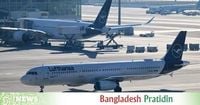On the evening of October 18, 2025, Munich Airport—one of Germany’s busiest aviation hubs—was thrown into temporary disarray following reports of drone sightings in its airspace. The incident, which unfolded in two distinct waves just an hour apart, led authorities to suspend airport operations twice for about half an hour each time, causing minor disruptions for travelers but ultimately raising bigger questions about airspace security across Europe.
The first reports came in around 10 p.m. local time, when several people—including security officials and airport employees—alerted federal police and airport authorities to what they described as “suspicious observations.” According to the Associated Press, these sightings prompted an immediate response, with airport operations being halted as a precaution. The closure lasted roughly 30 minutes before flights briefly resumed, only for a second round of reports to trigger another half-hour shutdown around 11 p.m.
During these tense intervals, federal police and security teams scoured the area in search of any sign of drones or suspicious individuals. Despite their efforts, no drones were found, and no unauthorized persons were detected in or around the airport. As federal police later confirmed, “no drones or suspicious people were found in the area.”
By midnight, the airport had reopened, and by the morning of October 19, 2025, air traffic was operating normally once again. The airport’s management was quick to reassure the public that the impact on flights and passengers had been minimal. Only three incoming flights were diverted—two of which were able to land in Munich later in the night—and one scheduled departure was canceled. For most travelers, the disruptions amounted to little more than an inconvenience.
Still, the incident was far from isolated. As reported by AP and echoed by several international outlets, this was merely the latest in a string of drone-related disruptions affecting major European airports. Earlier in October 2025, Munich Airport had been forced to close twice within a 24-hour period after similar drone sightings, an episode that impacted thousands of passengers. On October 2, for instance, restrictions and a full halt to flights left about 3,000 travelers stranded, with 17 flights unable to take off and 15 arriving flights diverted to other cities including Stuttgart, Nuremberg, Vienna, and Frankfurt. Less than a day later, a second closure compounded the chaos.
These repeated shutdowns are not unique to Munich but are part of a broader trend that has seen mysterious drone overflights disrupt airspace across the European Union. The pattern has left airport operators, police, and regulators scrambling to balance passenger safety with the need to keep Europe’s vital aviation arteries flowing smoothly. As the Associated Press noted, “the closure is the latest after mysterious drone overflights in the airspace of European Union member countries.”
For aviation authorities, the stakes are high. Even unconfirmed reports of drones near airports can trigger strict safety protocols, leading to flight delays, diversions, and cancellations. The rationale is clear: drones, if present, pose a serious risk to aircraft during takeoff and landing, when planes are most vulnerable. The mere suspicion of a drone in restricted airspace is enough to halt operations until the threat can be fully assessed and neutralized.
Yet, as the Munich incidents demonstrate, verifying such threats is often easier said than done. In all cases this October, including the most recent, thorough searches by federal police failed to turn up any evidence of drones or individuals operating them. The lack of physical confirmation has fueled debate among experts and policymakers about how best to respond to such sightings, especially when they come from credible sources like airport staff and security personnel.
Some in the aviation industry argue that the current protocols, while disruptive, are necessary to ensure the highest levels of safety. Others contend that more sophisticated monitoring and detection systems are needed to distinguish between real and false alarms, thereby minimizing unnecessary closures. In the words of one airport official cited by AP, the events “underscore the need to strengthen airspace control around major airports and to enhance readiness to respond quickly to similar threats to flight safety.”
Indeed, the October shutdowns have prompted renewed calls for investment in advanced airspace monitoring technology. Such systems, advocates say, could help authorities quickly pinpoint the presence (or absence) of drones, reducing the likelihood of false positives and the operational headaches that follow. The incidents also highlight the importance of rapid coordination among airports, police, and airlines to ensure that disruptions are kept to an absolute minimum.
For travelers passing through Munich Airport on October 18, the experience was a brief reminder of the vulnerabilities that come with modern air travel. Most were able to continue their journeys with only minor delays, but the underlying issue remains unresolved. As drone technology becomes increasingly accessible, the challenge of keeping unauthorized devices out of sensitive airspace is only likely to grow.
Meanwhile, the broader European aviation community continues to grapple with the implications of these incidents. While no harm came to passengers or aircraft during the Munich closures, the potential for more serious consequences cannot be ignored. The events of October 2025 serve as a wake-up call for regulators and industry leaders alike: the skies may be clear for now, but vigilance and innovation will be key to ensuring they stay that way.
As normal operations resumed at Munich Airport and passengers moved on with their travels, the memory of yet another drone scare lingered—a testament to the ongoing tension between convenience, security, and the ever-evolving technology that shapes our world.




